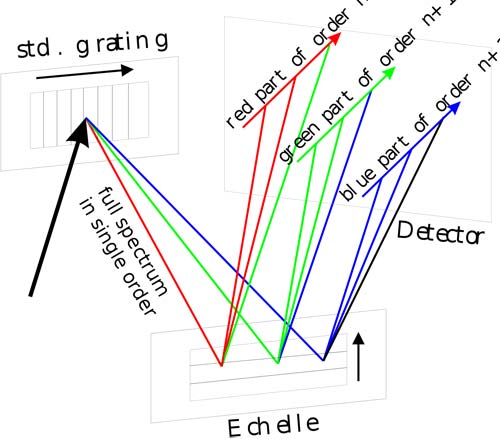échelle grating

The first standard grating is optimized for a single lower order, while multiple higher orders of the echelle have an optimized output intensity. Both diffractive elements are mounted orthogonally in such a way that the highly illuminated orders of the échelle are transversally separated. Since only parts of the full spectrum of each individual order lie in the illuminated region, only portions of the different orders overlap spectrally (i.e. green line in red portion).
An échelle grating is a diffraction grating in which the grooves are quite widely spaced and have a zigzag or step-like cross-sectional profile; the name is French for “ladder.” The light to be dispersed is made to fall on the grating at right angles to the faces of the grooves. This has the effect of producing a series of overlapping spectra with a high degree of resolution. A second, low-dispersion grating, or a prism, arranged perpendicular to the échelle, serves to separate out the overlapping spectra.
Theory of the échelle grating
In studies of high resolution diffraction gratings, it is observed that resolving power at a given wavelength depends only on the ruled width of the grating and the angles of illumination and observation, and not specifically on the number of ruled grooves. The ruling of many inches of a grating with a few tens of thousand of lines per inch is hard to achieve. An échelle grating has very fine lines ruled much further apart than is customary. Such a grating has very high resolution, but only over a quite narrow band of wavelengths. Hence it is customary to cross an échelle grating with a second grating (or prism) of lower resolving power, thus producing what is essentially a two-dimensional spectrogram or échellegram.
The resolving power of a diffraction grating depends primarily on the total ruled width and the angles of incidence and refraction. Thus high resolving power should be obtainable with coarse rulings, 100 or so per inch, if the grooves are properly shaped. When the grooves are fixed to reflect light of all colors in a narrow bundle, the resulting échelle grating may have a resolving power equivalent to that of a diffraction grating with 30,000 lines per inch. It lacks, however the angular dispersion needed to separate the spectra of consecutive orders; thus this grating is usually crossed with a prism or another gating of lower resolving power.


